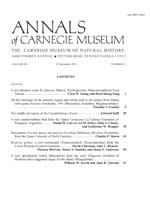Enantiornithes is a diverse clade of Mesozoic birds first recognized from the Upper Cretaceous sediments of a South American locality in northern Argentina. Extensive discoveries of Mesozoic birds have since been made globally, and three other South American localities have subsequently produced enantiornithine material. Here, we report an enantiornithine specimen from a new locality in the Upper Cretaceous La Colonia Formation of Patagonia, Argentina. Although mammals and other vertebrate fossils have been reported from the site, this new specimen is the first bird. The specimen, from deposits assessed to be Maastrichtian in age, is the uncrushed distal end of a right humerus with well-preserved muscle scars. The following characters support its referral to Enantiornithes: (1) weakly developed distal condyles; (2) anteroposterior distal compression and transverse expansion of the humerus; and (3) distal projection of the ventral epicondyle. The specimen is differentiated from most other Enantiornithes by the development of a ridge on the dorsodistal edge of the ventral condyle and by a thin crest on the ventral margin of the humerus, which is interpreted as bordering a ventrally displaced area of origin for m. brachialis. The ridge present on the edge of the ventral condyle is proposed to be possibly synapomorphic of a previously unrecognized enantiornithine subclade with a Laurasian and Gondwanan distribution, while the thin crest on the ventral margin of the humerus is recognized as a potential autapomorphy of this specimen. The presence of a dorsal supracondylar tubercle, like that in the new specimen and other avialans, is shown not to be an indicator of wading ecology as had been previously proposed. In sum, the new specimen expands our understanding of South American diversity in Avialae and morphological diversity in Enantiornithes. Further material will elucidate the phylogenetic relationships and taxonomic status of the new fossil.
How to translate text using browser tools
1 December 2011
A New Enantiornithine Bird from the Upper Cretaceous La Colonia Formation of Patagonia, Argentina
Daniel R. Lawver,
Aj M. Debee,
Julia A. Clarke,
Guillermo W. Rougier
ACCESS THE FULL ARTICLE

Annals of Carnegie Museum
Vol. 80 • No. 1
December 2011
Vol. 80 • No. 1
December 2011
Avialae
forelimb
Maastrichtian
Mesozoic
South America




